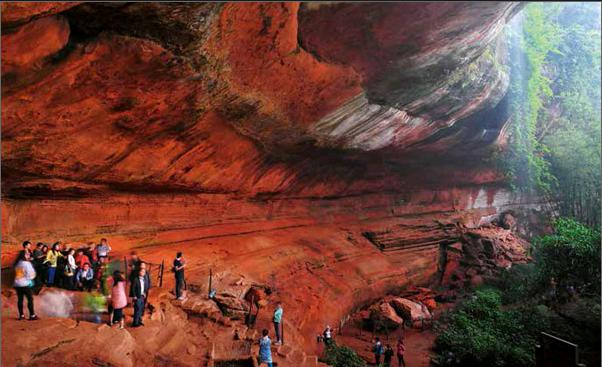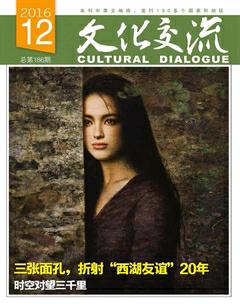读一读赤水丹霞
小昭

20世纪30年代,中国地质学者首先提出一个从约两亿年前侏罗纪开始形成的特殊地貌类型“丹霞地貌”的概念,当时有人嘲笑“不懂地质学的ABC”,可这一学说不但在中国发展起来,而且也为国际学界承认为“红层”。2010年,第34届世界遗产大会表决通过,将“中国丹霞”列入世界遗产名录。
那是一项世界自然遗产,由西南而华南而华东走向,从青年期而壮年期而老年期过程,以贵州赤水、福建泰宁、湖南崀山、广东丹霞山、江西龙虎山、浙江江郎山等6处极具代表性的丹霞发育提名地,系列组合而成。
申报世界遗产,从一开始,各地都热切期盼并努力追求文化型项目,对自然类项目相对比较冷落,这固然受客观条件限制,但一定也与某些认识有关:大自然不包含具体的人类活动内容;突出推崇中国文化更容易锦上添花。
一般而言,许多人把奇山异水仅仅当作纯粹的自然风光。其实,当人们把自然风物作为景观,就已经具有主观色彩,已经具有文化因子,只是抽象一点罢了。
我们遥远的祖先从对自然的崇拜起始来记录历史,从对自然的认识来创造科技,从对自然的描摹来创作文艺,从对自然的解释来阐述思想。
即就中国古代文学讲,《诗经》、汉赋、唐诗,有多少是在大自然中汲取出智慧,演绎了对生活方面、艺术方面、思想方面、哲学方面甚或宗教信仰方面的思考。中国的山水文学在世界上独一无二地丰富,涌现出像谢灵运和王维、孟浩然、李白、白居易以及苏轼这样的伟大文士。我们现在不也是常在讴歌山岳、海洋、草原、峡谷甚至荒漠吗?
人们发现大自然的美,感叹大自然的美,是因为它给予人感受,给予人启示,给予人联想,给予人愿望,进而给予人改变现实的力量。
我们实在应该读一读有历史、地理、文化、中外交通、民俗、神话等文献参考价值的志怪古籍《山海经》,那里面记载了民间传说中的山川地理知识,延伸于民族、道里、物产、祭祀、巫医等内容,尤其对矿物的记录是世界上最早的有关文献;然后也更应该读一读北魏时期的《水经注》和明清的地理笔记丛书。我们不是设立有自然保护区以及地质公园、海洋公园、森林公园吗,其初衷只为保护,不包括学术研究和更广泛的科学知识的传播吗?
具有风景观赏价值的世界自然遗产中国丹霞,同时更有科学价值。那么,我们现在就不妨来读一读有关中国丹霞的资料:
——在地质和地貌学上的丹霞定义是:一种地貌景观,像“玫瑰色的云彩”或者“深红色的霞光”。中国丹霞是一个由陡峭的悬崖、红色的山块、密集深切的峡谷、壮观的瀑布及碧绿的河溪构成的景观系统,整体为临水型峰丛—峰林景观,被天然森林广泛覆盖,是世界上最美丽的丹霞景观的例证。
——依据世界遗产标准,中国丹霞具有突出的普遍价值,即美学价值、地球科学价值、生态学价值与生物多样性价值:发育了绝妙的自然景观;是反映地球大陆地壳中生代以来演化特征的杰出范例;有环境的复杂多样性。
——中国丹霞满足了世界遗产标准:自然现象具有罕见的自然美;是地球演化史中重要阶段的突出例证,包括生命记载和地貌演变;代表了陆地、淡水、海岸和海洋生物系统及动植物群落演变、发展的生态和生理过程;是生物多样性原地保护的最重要的自然栖息地。
多深刻的阐述,我们以前的科学知识的贫乏由此可见一斑。
好多年前,我去参加浙江江郎山风景名胜区总体规划评审会,实地考察时,曾沿着陡窄的栈道攀上标志性景点“三爿石”中的郎峰,记忆十分深刻。申遗那会儿,我又去了江郎山,但对丹霞地貌特征上的突出的孤峰以及狭窄的巷谷、巨大的近垂直的石墙,印象不是很明确清晰。后来,我也去过江西龙虎山和广东丹霞山。此次到贵州就要到赤水看丹霞景观,我希望自己有完整的认识。
赤水市因赤水河而名,赤水河因丹霞而红。赤水丹霞是笼统的概念,它的面积在6处组合地中最为广阔,区域内国家重点风景名胜区、国家重点自然保护区以及国家地质公园、国家森林公园或有重叠。作为世界自然遗产,核心保护区并没有这么大,里面呈现的是青年期破碎山原的高峡幽谷,分布有赤壁、峡谷、瀑布、岩腔和大型崩塌巨石等发育齐全的景观,而壮年期起伏跌宕的峰林峰丛、老年期舒缓流畅的清秀山水则在其他五地。总体而言,赤水丹霞的发育美丽的景观在丹霞和瀑布,具有很强的视觉冲击力,不过在我看来,震撼之余更多平静,因为这地方大都有村子闲适、和美、静谧地坐落。
游赤水丹霞,以市区为住宿地,每天一个景区。
第一天去杨家岩。杨家岩洞崖丹霞和佛光岩墙面丹霞曾作为申遗的景观代表,我在《世界遗产》杂志上看到过。杨家岩洞崖丹霞崩坍了一部分,巨石的分裂磊落让人感叹自然的伟力。这处叫做“丹霞长廊”的,内凹而敞露的崖穴壁上有自然风化成如云如霞、肖物肖像的壁画石刻,这种地貌最先在广东丹霞山被学者研究,故称“丹霞地貌”。观音沟散布着瀑布群落,可作一帧帧半边一角的小景,印象深的是“溪谷琴韵”,流泉周边有鸟声掠过。
第二天去十丈洞。十丈洞是一条瀑布;十丈,言其极高、极大;洞,疾流,当地人即指瀑布。人说,水浩大时,十丈洞的流量超过贵州标志性景点黄果树瀑布,可惜我估摸不出。远远地站着,衣衫也湿,只觉得动地的水声使山林愈发静美起来。燕子洞前流过赤水河支流,岸石坡地呈现的丹霞色特别红,河床映衬得水流也特别红,红得人会起疑惑。
第三天去四洞沟。据说,赤水丹霞区域内有3000多条瀑布,我想,不论以高宽比例或倾斜角度,还是有无跌水潭或水流与地层倾斜方向划分,跌水的外观恐怕不会那么多。这里的水帘洞、月亮潭、飞蛙崖、白龙潭一线展开,有垂帘型、细长型、无理型、逆斜型,其实因为落水之潭有树石各异而形态精彩而令人思绪灵动。
第四天去金沙村。金沙沟一带有桫椤保护区。桫椤的出名珍贵在于它的古生态环境与丹霞形成同期,能遥想茫茫冰川期与恐龙化石并存的时代,但不一定非要在丹霞地区才能存活。桫椤由木本蕨类而生长成树木,茎干顶部有叶柄,叶片密被交织地向下弯,风姿属于山野美人一类,我在广西、海南、福建都有成片的野外所见,却很少一两株、两三株地在典雅园林中发现。桫椤之外这里多楠竹,农家制成筷子出售,我挑了一把清水的、方首圆足的,虽然连土宜都称不上,却可资纪念。与农人闲聊中我异想天开,建议在筷楞处烫印远古的两大标志桫椤与恐龙,农人愕然而茫然。
第五天去佛光岩和丙安古镇。佛光岩一带地质沉降急剧,切割典型,以五柱峰为主体景观,有宝塔状、城堡状、针状、柱状、棒状、方山状、峰林状等地貌。佛光岩瀑布倾斜而下,高度为赤水地区之冠。丙安是重要驿站,过去商旅云集,现在游人云集,有一街酒香。
居然在赤水游了五天,自己也想不到,但觉得值,不虚此行。
临了,再读一读“申遗”时国际专家对我们“自然国粹”的考察评价:
——新西兰奥克兰大学地理系教授、世界喀斯特专家保罗·威廉姆斯:“赤水丹霞……适宜成为一个重要的国家公园。”
——澳大利亚卧龙岗大学地球和环境科学院罗伯特·瑞博士:“赤水的确拥有非凡的自然和美学价值……很好地展示了现代侵蚀地质过程证据以及绝妙的切割砂岩地貌景观。瀑布也非常绝妙。”
——世界自然保护联盟喀斯特地貌与洞穴工作组主席J·安德森女士和保护管理专家R·安德森:“赤水丹霞同其他同等地貌相比,有杰出的表现,保护区和提名地中的核心区保护得很好,生态和生物多样性丰富。”
——英国生物多样性保护学者、世界自然保护联盟特聘专家约翰·马敬能博士:“我毫不怀疑该提名可以满足第七、第八条关于自然美和地球历史的评价标准。我同样认为其十分契合第九条关于生态过程的评价标准。”
(本文摄影:袁建平)
Guizhou is famed for the splendid glory of Danxia Landform along Chishui River. Danxia Landform was first identified by Chinese geologists in the 1930s after their intensive studies of Danxia Mountain in Guangdong Province in the south of China, hence the name.
At first, some snickered at the discovery believing the scholars had disregarded the basics of geology and got it all wrong. However, the classification has survived. Nowadays, Danxia Landform is academically recognized. In 2010, Danxia Landform of China was designated as a world natural heritage.
One swath of the landform stretches from the southwest to the east of China. The six sites included in the designation represent different ages of the landform: Chishui of Guizhou, Taining of Fujian, Liangshan of Hunan, Danxia Mountain of Guangdong, Longhu Mountain of Jiangxi and Jianglang Mountain of Zhejiang.
When China first became aware of the importance of the UNESCO heritage lists for identifying its own heritages and for better preserving them, the country gave top priority to cultural heritages. Few considered natural beauty as heritage. I differ. From the very beginning of Chinese literature, our ancestors upheld nature as the general clue for understanding art and literature. Nature was and has been considered as the inspiration for numerous masterpieces. The incredibly rich wealth of poems and essays testify to the Chinese philosophy that man and nature are one. Wang Wei, Meng Haoran, Li Bai, Bai Juyi, Su Shi, poets who spared no efforts to portray a synergy between man and nature, are of the greatest poets of China. Chinese poets have long since written odes to the beauty and grandeur of mountains, seas, grasslands, valleys and deserts.
Chishui City is named after the river. And Chishui in Chinese means Red River, referring to the sunlit reflections of the reddish cliffs on the river. Along the Chishui River are a national forest park, a national nature reserve, a national geological park, and a key national scenic zone, which combine to testify to the natural diversity of the landform and different focuses of the government at the central and local level. These zones overlap to varying degrees and they point to the importance of the Danxia cliffs. Here visitors can view red cliffs, deep valleys, waterfalls, small and shallow rock caves, and heaps of rocks after cliffs cracked and fell apart. These geological features display different phases of evolution that the landform has been going through. Generally speaking, the waterfalls and the red cliffs are more sensual and gratifying to the eye. But for me, the whole area bespeaks serenity as villages there look like Utopia.
I stayed at a hotel in the city and went out to explore different tourism attractions along the river. The first day saw me visit Yangjia Cliff. Though I had seen this part of the Danxia Landform in the photos of this scenic spot on magazine covers, the spectacle still overwhelmed me. Part of the red cliff had collapsed and the huge messy heaps of rocks indicate natures power. At one place, the cliff leans inward forming a long open shelter, which is called Danxia Corridor. In the corridor are images that look like objects and persons that appear as if created by man. But they are created and engraved by nature. The Guanyin Valley abounds with waterfalls. The sound of birds and streams was soothing.
The second day saw me go out to visit Shizhangdong, which is a waterfall. It is said that this waterfall gushes more water than does Huangguoshu Waterfall in the rainy season. That day, I wasnt able to see how the waterfall fell from high. I stood far away from it, getting wet by the mist created by the splashing waterfall. The roaring noise made the forest quiet. At another waterfall, I saw a small river that empties into Chishui River. The reddish rocks stretched down into the river and made the water so red that the color was surreal.
On the third day, I visited Sidong Valley. That day, I was able to admire different shapes of waterfalls. It is said that in the Valley of Chishui River there are more than 3,000 waterfalls. And these waterfalls there find a great number of ways to cascade from cliffs to touch the rocks, caves and trees down there.
On the fourth day, I visited Jinsha Village. Jinsha Valley nearby is a nature reserve for Cyatheaceae , huge fern trees that go back to the Jurassic era. The trees are precious largely because they came around in the same age when the Danxia Landform appeared. The place also abounds with bamboo. Local farmers make bamboo chopsticks. I bought a bundle of chopsticks as keepsake. In a casual chat with the vendor, I jokingly suggested that the images of dinosaur and Cyatheaceae be printed on the chopsticks. The farmer looked extremely puzzled, for he didnt know what I was talking about.
On the fifth day I visited Foguang Cliffs and Bingan, an ancient town. Foguang Cliffs display a full range of rock formations. They respectively look like a fortress, needles and pillars, pagodas, and a stone forest. There is a waterfall cascading down. It is said to be the tallest waterfall in the area. Bingan used to be a trade outpost where business gravitated. Nowadays, tourists gather.
I hadnt had any idea that I would need five days to take a cursive look at scenic attractions along the Chishui River. What I saw and witnessed there fit my understanding of nature and the aesthetics that nature has taught me.

